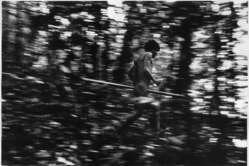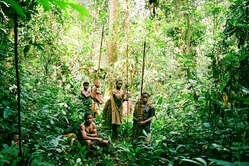
©Claudia Andujar
August 9 is UN World Indigenous Day. From the hunting peoples of Canada to the hunter-gatherers of Africa, tribal peoples have found ingenious ways of surviving over thousands of years.
For many tribal peoples, continuous immersion in nature over thousands of years has resulted in a profound attunement to the subtle cues of the natural world.
Acute observations have taught tribes how to hunt wild game and gather roots and berries, how to sense changes in climate, predict movements of ice sheets, the return of migrating geese and the flowering seasons of fruit trees. Sophisticated hunting, tracking, husbandry and navigation techniques have also been the ingenious responses of tribal peoples to the challenges of varied, and often hostile, environments.
The development of such observations and skills is not only testament to the latent creativity of humans and their extraordinary ability to adapt, but has also ensured that when living on their lands, employing the techniques they have honed over generations, tribal peoples are typically healthy, self-sufficient and happy.

©James Morgan
The Moken 'sea gypsies' of the Andaman Sea have developed the unique ability to focus under water, in order to dive for food on the sea floor. Their sight is 50% more acute than Europeans'.

©Kate Eshelby
Most tribal peoples are sensitively attuned to animal behavior. Pygmy men are such proficient mimics they can imitate the sound of a distressed antelope in order to lure another out of the bush. Similarly, Siberian hunters are able to mimic the cry of a reindeer calf looking for its mother or the bark of a rutting male.

©Dominick Tyler
A Bushman woman in Botswana chews the flesh of a melon for its moisture.
Traditionally, the Bushmen find water in 'pans' - rain-filled depressions in the sand - and from plants such as tsamma melons and roots, techniques learned over thousands of years of surviving in the desert during the dry seasons, when the water-holes of the Kalahari sand-face turn to dust.
"You learn what the land tells you', says Gana Bushman Roy Sesana.

©Joanna Eede
The bowstrings of the Hadza tribe of Tanzania are made from animal ligaments; the arrows meticulously crafted from 'kongoroko' wood and fletched with guineafowl feathers.
The sap of the desert rose shrub is used to coat the arrow tips in poison.

Tribal peoples perhaps still know better than most that the delicate balance of man and nature has only been maintained for millennia through a respect for its limits. It is no coincidence that many areas that are the richest in biodiversity remain so due to the care of their tribal guardians.
The Awá leave little sign of having passed through the forest other than disturbed liana leaves and marks on tree trunks; the Yanomami's fish poison breaks down rapidly in the water, leaving no pollution; the Innu carefully preserve caribou leg bones and hang antlers high in trees as a mark of respect to the animal.
Responsibility and reciprocity are vital requirements for survival; to take more than is needed or to degrade the earth is not only self-defeating, but a neglect of their unborn children. 'We hunt selectively', say the Penan. 'We only hunt for our needs'.
